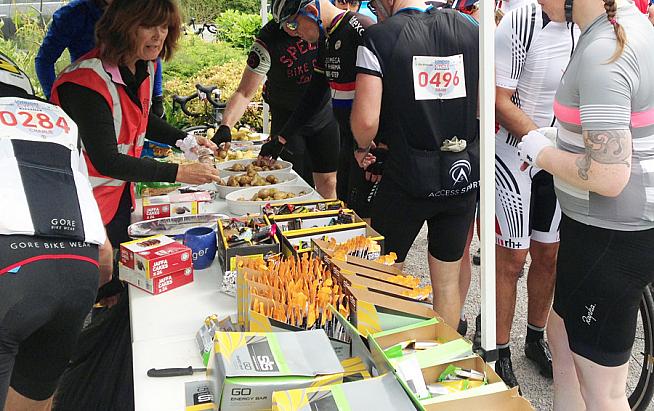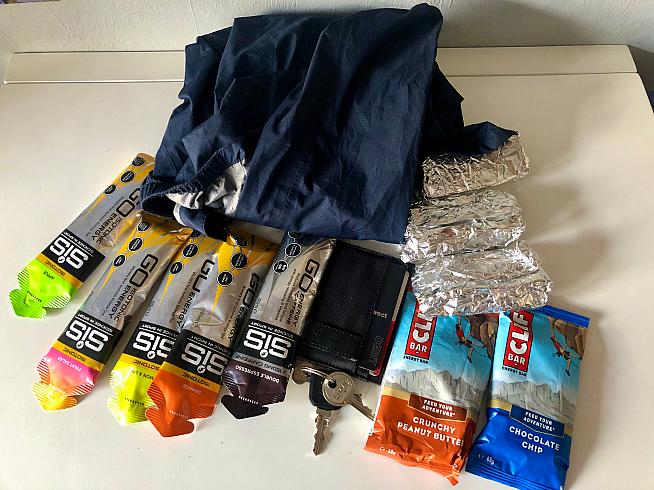Due to obvious reasons it's been well over a year since a lot of us took part in our last sportive. With a return to organised outdoor events now on the horizon, it's the perfect time to go back to basics and make sure you are as prepared as possible.
So whether you're a hardened sportive veteran or a newcomer taking your first steps into the world of endurance events, here is our guide to mastering your big ride nutrition.

Pre-Event
An important part of pre-event preparation is to ensure your muscles' glycogen (energy) stores are well stocked. Historically this has taken the form of 'carbohydrate loading'. Many amateur athletes took this name to heart and tried to force down mountains of pasta the night before an event. Hoping the more carbs they consumed, the more energy they would have.
While you do need to ensure those stores are topped up, there is a limited amount of glycogen that can be stored in your muscles. Eating more isn't going to magically increase that amount!
Instead, ensure that in the days running up to your event you increase your carbohydrate intake gently. Try to aim for 8-10g of carbs per kg of bodyweight a day, and remember carbs don't have to just be rice and pasta. Try including fresh and dried fruits, cereals, smoothies and sports drinks, even a soft drink or cheeky pastry can help top up your carbs while keeping things interesting (and tasty!).
Another important tip is to ensure you are keeping well hydrated. Not only does this help with digestion and carb absorption, but it ensures you don't need to play catch up on the morning of the event.
The morning of the event
The age-old adage that breakfast is the most important meal of the day definitely holds true when it comes to endurance rides. This is your last chance to ensure those glycogen stores are topped up before your event.
The same rules that apply to carb loading apply to breakfast. Try to avoid overdoing it with a big meal. Doing so can leave you bloated and uncomfortable for your event, with blood still sat in the stomach aiding digestion rather than going to your legs. Instead try aiming for 2g of carbs per kg of bodyweight around 1.5-2 hours before the start.
A solid option for breakfast is a large bowl of cereal or porridge with some dried fruit. Top this up with some toast with jam or a banana and a sweet tea or sports drink. Don't be tempted to reach for energy gels instead. They lead to a sugar rush that is best kept for when you are on your bike.
Again make sure you don't neglect your hydration. If you've been keeping hydrated in the days before the event then around 500ml throughout the morning leading up to the event should be plenty.
During the ride
You've got your glycogen stores fully loaded, you're well hydrated and you've started your ride. How do you make the most of your preparation and ensure you stay optimally fuelled?
With the excitement of an event it's surprisingly easy to forget to fuel regularly. Even with perfect carb loading, glycogen stores will only last for around 90 minutes. So it's crucial to start fuelling well before that point. Try setting a timer on your cycling computer or making a mental note to fuel every 20-30 minutes.
How much fuel you're able to consume will depend on you and your fuel of choice. A common figure to aim for is 1g of carbs per kg bodyweight per hour. This may not be achievable for everyone, but most should aim for at least 60g of carbs an hour.

It's important to recognise that everyone is different when it comes to nutrition. Some athletes can fuel long intense rides off energy gels alone, others struggle to stomach sports nutrition and need 'real' food to get by. Test out a mix of gels, sports drinks and whole foods in the run up to your event or big rides to understand what works best for you.
So how does this work in practice? Let's take the example of 60g of carbs an hour and see how that can be achieved. A typical energy gel will contain 20-25g of carbs. An energy drink between 40-50g. Flapjacks and energy bars can vary between 20-40g depending on their size. Sixty grams of carbs can easily be achieved by taking on a gel, a bar and sipping on an energy drink throughout the hour.
Find a combination that works for you and stick to it. Try to avoid trying out new products or changing your fuelling strategy too much on the day of your event. This may cause discomfort and affect your performance.
After your event
So you got through your big ride, didn't have any fuelling disasters or hit the wall, and now you're basking in the endorphins. It's important you get some post ride nutrition so your body can fully recover.
There are two main aspects of recovery nutrition to consider. The first is the type of food you consume and the second is when you consume it.
Aim to get some food in your body as quickly as possible after finishing your ride. There is around a 45-minute window for optimum recovery, but the sooner the better! A recovery drink or even a milkshake is an easy place to start and also helps with hydration. Follow this with a more substantial meal.
Ask most athletes and they'll tell you protein is the most important food for recovery. It's actually now widely recognised that carbohydrates play a larger part. Ideally aim for a 3:1 ratio of carbohydrates to protein in your recovery meal. Pasta with a lean protein like chicken, or even beans on toast, are solid recovery options.
Our top tips
- Hydrate, hydrate, hydrate! Hydration is often overlooked by endurance athletes. Aim for 500-750ml an hour - at least a small bidon - and make sure to start sipping before you feel thirsty. Often people make extra effort to hydrate when it's hot which is good practice, but it's just important when the weather is cooler too.
- Be prepared to modify your strategy if the course demands it. If the first half of the course is especially hilly or is going into a headwind, you will be using more energy. Make sure you take on more fuel to reflect this.
- Carbohydrates aren't everything. Athletes lose a large amount of salts throughout a big ride that need replacing. A common method is to use supplements, however many energy gels also now include them.
To learn more about Blackzone Coaching and to discuss how a tailored training programme could make 2021 your best ever year in the saddle, get in touch by visiting the official website.
0 Comments





